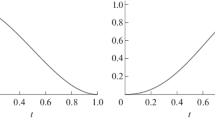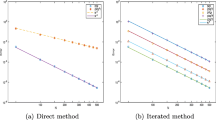Abstract
Cubic-spline and discrete-quadratic polynomial techniques are presented for reliably computing up to third-order derivatives of experimental information. The concept is demonstrated by stress analyzing from measured displacements a transversely loaded plate and a beam under four-point bending. The respective displacement fields were recorded using holography and moiré. The accuracy of the employed numerical-differentiation techniques is indicated.
Similar content being viewed by others
Abbreviations
- x :
-
independent variable
- y=y(x) :
-
theoretical relationship
- y′, y″, y‴ :
-
analytical derivatives from theoretical coordinates (x, y)
- R((Y; x) :
-
cubic-spline polynomial
- I (Y; x) :
-
cubic-spline interpolation polynomial
- L (Y; x) :
-
discrete-quadratic polynomial
- R′(x, y), L′(x, y) :
-
numerical derivatives from theoretical coordinates (x, y)
- R′, L′ :
-
numerical derivatives from smoothed input data represented byR(Y; x) orL(Y; x), respectively
- R″, L″ :
-
numerical second derivatives from smoothedR′ orL′ input data, respectively
- \(\frac{{\partial ^2 R}}{{\partial x^2 }}, \frac{{\partial ^2 L}}{{\partial x^2 }}\) :
-
numerical second derivatives computed directly from smoothed input data represented byR (Y; x) orL (Y; x), respectively
References
DeJosselin de Jong, G., “Moiré Patterns of the Membrane Analogy for Ground-Water Movement Applied to Multiple Fluid Flow,”J. Geophysics Res.,66 (10),3625–3629 (Oct. 1961).
Sokolnikoff, I. S., Mathematical Theory of Elasticity, McGraw-Hill (1956).
Zienkiewicz, O. C. and Cheung, Y. K., The Finite-Element Method, McGraw-Hill (1967).
Theocaris, P. S., Moiré Fringes in Strain Analysis, Pergamon Press (1969).
Durelli, A. J. and Parks, V. J., Moiré Analysis of Strain, Prentice-Hall (1970).
Post, D. and MacLaughlin, T. F., “Strain Analysis by Moiré Fringe Multiplication,” Proc. SESA,XVIII (2), 408–413.
Swinson, W. F. andBowman, C. E., “Application of Scattered-light Photoelasticity to Doubly Connected Tapered Torsion Bars,”Experimental Mechanics,6 (6),297–305 (1966).
Berghaus, D. G. andCannon, J. P., “Obtaining Derivatives from Experimental Data Using Smoothed-spline Functions,”Experimental Mechanics,13 (1),38–42 (1973);also Berghaus, D. G., “Adopting the Scattered-light Photoelastic Method for Three-Dimensional Stress Analysis in Multilayered Composites,” PhD Thesis, School of Engineering, Case Western Reserve University, Cleveland (1969).
Olson, D. L., “A Photomechanic System for Nondestructive Three-Dimensional Stress Analysis,”PhD Thesis, Dept. of Agric. Engr., Iowa State Univ., Ames, IA (1970).
Tychonov, A. N. and Samarski, A. A., Partial Differential Equations of Mathematical Physics, Holden-Day, Inc., 153–157 (1964).
Moler, C. B. andSolomon, L. P., “Use of Splines and Numerical Integration in Geometrical Acoustics,”J. Acoust. Soc. America,48 (3),739–744 (Sept. 1970).
Lark, P. D., Craven, B. R. and Bosworth, R. C. L., The Handling of Chemical Data, Pergamon Press, 288–292 (1968).
Statistics and Mathematics in Biology, Ed. by O. Kempthorne, T. A. Bancraft, J. W. Gowen and J. L. Lush, Iowa State College Press, 119–132, 345–360 (1954).
Goldstein, A., Biostatistics, MacMillan Company, New York, 147–154 (1964).
Boone, P. andVerbiest, R., “Application of Hologram Interferometry to Plate Deformation and Translation Measurement,”Optica Acta,16 (5),555–567 (1969);also, Soete, W., Dechaene, R. and Boone, P., “Toepassingen Van de Holografie, Part A,” Research Report, Univ. of Gent, Belgium (1970).
Rowlands, R. E. andDaniel, I. M., “Application of Holography to Anisotropic Composite Plates,”Experimental Mechanics,12 (2),75–82 (1972).
Daniel, I. M., Rowlands, R. E. and Post, D., “Moiré Methods for Strain Analysis of Composites,” SESA Spring Meeting, Cleveland, OH (May 23–26, 1972).
Stetson, K. A., “Moiré Method for Determining Bending Moments from Hologram Interferometry,”Optics Technology,2,80–84 (1970).
Brandt, G. B. and Taylor, L. H., “Holographic Strain Analysis Using Spline Functions,” Symposium on Engineering Applications of Holography, Los Angeles (Feb., 1972); also, Taylor, L. H. and Brandt, C. B., “An Error Analysis of Holographic Strains Determined by Cubic Splines,” Experimental Mechanics,12 (12), 543–548 (1972).
Ahlberg, J. H., Nilson, E. N. and Walsh, H. L., The Theory of Splines and Their Applications, Academic Press (1967).
Greville, T. N. E., Theory and Application of Spline Functions, Academic Press (1969).
Reinsch, C. H., “Smoothing by Spline Functions,”Numerische Mathematik,10,177–183 (1967).
Liber, T., et al., “Shock Isolation Elements Testing for High-Speed Input Loading-Foam Shock Isolation Elements,” SAMSO Tech. Report TR69-118,II (June 1969).
Timoshenko, S. and Woinowsky-Krieger, S., Theory of Plates and Shells, McGraw-Hill (1959).
Rowlands, R. E., Liber, T., Daniel, I. M. and Rose, P. G., “Holographic Stress Analysis of Composite Plates,” 13th International Congress of Theoretical and Applied Mechanics, Moscow, USSR (August 1972).
Durelli, A. J. and Daniel, I. M., “Structural Model Analysis by Means of Moiré Fringe,” Proc. ASCE (Struct. Division), 93–102 (Dec. 1960).
Author information
Authors and Affiliations
Rights and permissions
About this article
Cite this article
Rowlands, R.E., Liber, T., Daniel, I.M. et al. Higher-order numerical differentiation of experimental information. Experimental Mechanics 13, 105–112 (1973). https://doi.org/10.1007/BF02323967
Received:
Revised:
Issue Date:
DOI: https://doi.org/10.1007/BF02323967




